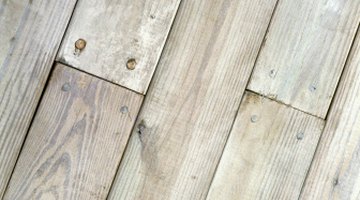How to Bleach Hard Wood Floors
Bleaching your hardwood floor is an option when you have stubborn stains that will not disappear. There are three common methods for wood beaching: household bleach, oxalic acid, or a two-part kit containing hydrogen peroxide and sodium hydroxide. Choose a method based on the stain composition.

Household bleach--the weakest type--treats ink stains, blood, juice spills and similar stains. Oxalic acid tackles black discoloration from age, water damage or rust stains. A two-part bleach kit--the strongest form--is usually reserved as a last resort.
Things You Will Need
- Sandpaper or chemical stripper
- Shock treatment for swimming pools (dry calcium or sodium hypochlorite)
- Chlorine bleach
- Plastic container
- Stiff-bristled brush
- Soft, dry rag
- Vinegar
- Oxalic acid
- Hydrogen peroxide
- Sodium hydroxide
Chlorine Bleach
-
Sand the floor where you wish to bleach it to remove existing finish. Wipe on a chemical stripper if necessary to remove all the finish. Sanding is better, as you might sand some of the stain away while you work.
-
Mix shock treatment for swimming pools (dry calcium or sodium hypochlorite) with hot water in a plastic container. Use liquid household chlorine bleach if preferred, pouring a couple teaspoons at a time to the stained surface. Work either shock treatment or household bleach into the wood and stain, brushing it in with a stiff-bristled brush. Wait at least 10 minutes before wiping off with a soft, dry rag. Reapply if stain persists, leaving bleach on up to 24 hours.
-
Wipe remaining bleach off the stained area with a soft cloth. Pour a 1/4 cup of vinegar on the area to neutralize the bleach. Rinse with water. Avoid using excessive amounts of liquid, which may swell the wood. Wipe the water off immediately and allow the stained area to dry overnight.
Oxalic Acid
-
Strip your hardwood floor finish off by either sanding it or applying a chemical stripper. Wipe off to clean before applying bleach.
-
Dissolve 2 oz. of oxalic acid in a quart of water, using a plastic container to mix. Use very hot water for best results.
-
Brush the oxalic acid solution on to the hardwood floor stain, using a stiff-bristled brush. Allow the oxalic acid to remain until the stain lightens; reapply as necessary and scrub again with the brush.
-
Wipe the oxalic acid solution up with a soft rag once the stain lightens. Rinse with 1/4 cup vinegar, then wipe away. Follow with a water rinse, using enough to saturate entire area. Dry with your cloth and allow to air dry at least 24 hours.
2-Part Bleaches
-
Strip wood of finish with a chemical stripper or by sanding. Clean dust or residue before continuing.
-
Dampen the stained area of hardwood flooring with a sponge to prevent the wood from soaking up too much bleach.
-
Mix the two ingredients of the bleach kit together, in a plastic container, following any product instructions provided. Immediately paint the bleach on the the wood floor stain, using a stiff-bristled brush.
-
Wait about 10 minutes before checking the stain progress. Wipe off with a rag, and reapply if necessary. Rinse with water when complete; the two-part bleach kits contain their own bleach neutralizer. Do not refinish the bleached area for at least 24 hours.
Tip
Bleaching may make it hard to blend a new finish with the surrounding old finish. Bleaching can also cause raised grain patterns.
Warning
Always wear rubber gloves when applying bleach, and make sure there is adequate ventilation. Avoid breathing powder bleach particles as well.
The Drip Cap
- Bleaching your hardwood floor is an option when you have stubborn stains that will not disappear.
- Reapply if stain persists, leaving bleach on up to 24 hours.
- Pour a 1/4 cup of vinegar on the area to neutralize the bleach.
- Brush the oxalic acid solution on to the hardwood floor stain, using a stiff-bristled brush.
- Dry with your cloth and allow to air dry at least 24 hours.
- Strip wood of finish with a chemical stripper or by sanding.
- Rinse with water when complete; the two-part bleach kits contain their own bleach neutralizer.
- Do not refinish the bleached area for at least 24 hours.
References
Writer Bio
Karie Fay earned a Bachelor of Science in psychology with a minor in law from the University of Arkansas at Monticello. After growing up in construction and with more than 30 years in the field, she believes a girl can swing a hammer with the best of them. She enjoys "green" or innovative solutions and unusual construction.
Photo Credits
- Joe Ginsberg/Photodisc/Getty Images
- Joe Ginsberg/Photodisc/Getty Images
More Articles



